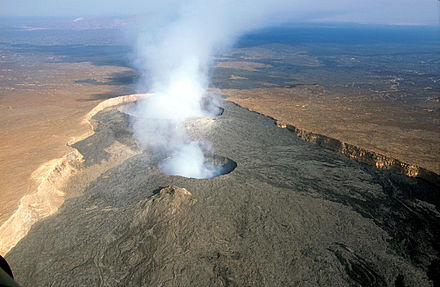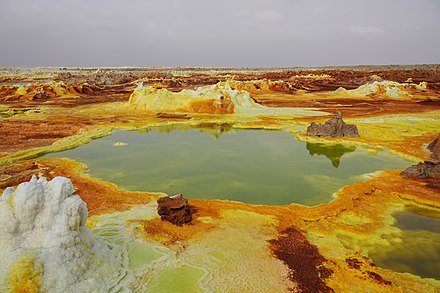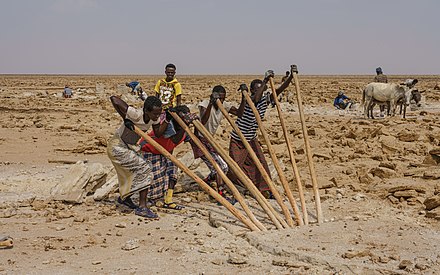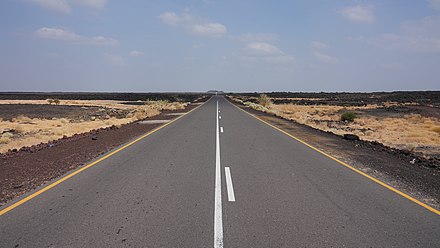Danakil Depression - geological depression, northern part of the Afar Triangle or Afar Depression in Ethiopia
The Danakil Depression is a desert area in the Afar region of northeastern Ethiopia, north of the Great Rift Valley that is widely known locally as the Dallol depression.
This is both the hottest region on earth averaged year round and one of the most geologically active. It is an area of singular geological fascination. A strange lunar landscape studded with active volcanoes malodorous sulphur-caked hot springs, solidified black lava flows, and vast salt encrusted basins.
Understand
Climate
The main season to visit is between November and February, when the temperatures are just hot (+30°C in the shade); the rest of the year it's extremely hot (approaching +50°C). Rain falls on average every 8-9 months.
People
This is the land of "Ardi" (Ardipithecus ramidus) and "Lucy" (Australopithecus afarensis) - hominids which have been proposed as among our first putative ancestors. In June 2010, the oldest direct evidence of stone tool manufacture was found in this region and attributed to Australopithecus afarensis hominids dating back more than three million years ago.
Near the southern end of the Red Sea an immense, more or less triangular, depression descends far below sea level - some points near the ghost town of Dallol are nearly 120 m below sea level). Known as the Danakil/Dallol Depression, the northern part is extremely hot and dry and an extension of the Great Rift Valley. In this seemingly inhospitable area live the nomadic Afar people who number about 3 million and largely disregard the notional borders between Ethiopia, Eritrea, Djibouti and Somaliland. Salt mining is the main economic activity and the region is poor also by Ethiopian standards. The unusual landscapes do draw visitors, but tourist infrastructure is scarce, though this may change in the future with heavy Chinese investment in the region
Geology
The whole Afar Depression is a plate tectonic triple junction where the spreading submarine ridges that formed the Red Sea and the Gulf of Aden emerge on land and meet the East African Rift. The Afar Depression is one of two places on Earth where a mid-ocean ridge can be studied on land, the other being Iceland. The Afar is slowly being pulled apart at a rate of 1-2 cm per year. The floor of the Afar Depression is composed mostly of basaltic lava. The Afar Depression and Triple Junction also mark the location of a mantle plume, a great uprising of the earth's mantle that melts to yield basalt.
This place, which used to be part of the Red Sea, has kilometres of salt deposits. In some places, the salt deposits are about 5 km thick. Below many salt lakes are substantial sources of volcanic heat which causes hot water to rise through layers of salt and deposit anhydrites. Minerals also get dissolved and are deposited near the springs, and form shapes very much reminiscent (but smaller than) hornitos on basaltic lava flows. Sulphur, other minerals and possibly Thermopylae bacteria cause spectacular colours.

This is a vast expanse of blisteringly hot desert, with lava flows and salt plains and lakes that lie below sea level. Active and extinct volcanoes lie along a south–north axis with the extremely salty Lake Afrera, at 120 m below sea level, kept alive by the many thermal springs feeding it.
Landscapes

Dallol offers an opportunity to see the first signs of a new ocean basin forming. The Dallol volcano, the only volcanic crater below sea level on land, has remained dormant since 1926, as the seabed it will one day occupy gradually widens. South of Dallol, rectangular salt slabs are cut and transported up into the highlands in a near endless procession of camel caravans. The salt canyons south of Dallol Mountain are some of the most impressive geological features in the area. It looks like another planet because there are lots of colourful rocks in each metre of terrain. It looks like something out of a science fiction novel.
Dallol is at the northern-most extension of the Great Rift valley - the largest geographical feature in Africa (if you discount the erg and reg of the Sahara) and the only such feature easily discernible from the Moon by the first Americans to walk there. Because it's below sea level it seems to trap all the heat. The most recent of its craters, Dallol, was formed during an eruption in 1926. Colourful hot brine springs and fumarole deposits are found in the Dallol area with some areas that are more than 116 m (328 ft) below sea level. There are hot yellow sulphur fields among the sparkling white salt beds. Heat isn’t the only thing people feel in the Dallol Depression. Alarming earth tremors are frequently felt. There are also several active volcanoes.
Erta Ale, an active shield volcano, is another impressive natural phenomenon. It is the most active volcano in Ethiopia. Erta Ale is 613m tall, with a lava lake, one of only five in the world, at the summit. It is the longest existing lava lake, present since 1906. Erta Ale, in whose crater lies the world’s only below sea level land volcano, has techni-colored landscapes, incredible mineral deposits. Sulphur lakes and bubbling sulphur springs are fascinating sights not to be missed.
The ghost town of Dallol, built from salt blocks and which almost straddles the Eritrean border to the east of the Tigrayan highlands, is officially listed as the hottest place on Earth, with an average annual temperature of 35 °C and hottest daily temperatures topping 40 °C year round. Much of this vast and practically unpopulated region lies below the driest and most tectonically active areas on the planet. It is some measure of the Danakil’s geological activity that more than 30 active or dormant volcanoes roughly one quarter of the total as listed by the Smithsonian instituted global volcanism program. These volcanoes are all geological infants having formed over the past million years and with a great many taking their present shape within the last 10,000 years.
Get in
Mekele is a common starting point for tours into the Danakil. In the 21st century the Chinese have built paved roads in the region making it much quicker and comfortable to get around. From Mekele it's three hours on the road to Berhale, which is the closest village to Dallol. From there, there's a one-hour drive along a dirt track to Hamad-Ela, which is a kind of base camp for exploring Dallol and Lake Kerum. From the base camp, there's one more hour of driving on a dirt track and along the salt crust of Lake Kerum and finally a 15-minute walk to reach the sulfur springs.
Mount Ertale is reached from Abala, from where there's a several hours' drive, first along a paved road, and then along a desert and basalt road to the base camp. The base camp is also a military camp. From there it's a hike, 2.5-3 hours in each direction to the mountain. Tours are accompanied by camels, who can be ridden by people as an alternative to hiking (for a small fee).
The Danakil Depression may not be visited on your own; not only is there are risk for terrorism and other violence, but it's also a harsh desert environment. The way to travel is on an organized tour including a guide and a military guard; tours usually take two (rushing), three (enough time to see the important attractions), or four days (to see the attractions at a calmer pace). Mekele is where tour normally start - every day during peak season. Tour operators include ETT Travel, Ethiodanakil Tours, and Awaze Tours. Moreover there are tours from Addis Ababa where you fly into Mekele early in the first morning, and back in the last evening.
Get around
Where there are drivable roads you will get around by car, elsewhere by camel or donkey. Forget about hiking, cycling or public transportation of any kind.
See


-
Lake Karum, 14.03°, 40.4°. Not to be confused with Lake Assal in Djibouti. This salt lake, one of three in Danakil, is 116 m above sea level and has a surface of . Near the shore, the salt surface is hard enough to drive on, like a frozen-over lake. The salt flats are mined by hand, with the slabs of salt loaded onto to camel trains and taken to Hamed Ela, from where they are trucked to Mekele. Salt has been mined here this way for centuries.
-
Lake Bakili, 13.94°, 40.5°. Another salt lake, southeast of the former, and in size. This place isn't often included in the tour itineraries.
-
Dallol volcano, 14.241°, 40.299°. For many the highlight on a trip to Danakil and sometimes referred to as the Yellowstone of Africa. This is an active volcano less than 100 m in height from the ground (the summit is still below sea level) and its crater is 1450 m across. The rock formations are made up of different salts, sulfur (yes, it smells like rotten eggs here), iron compounds and andesite, and the surroundings with their unusual colors may make you think you're on another planet. The landscape got its current form in the last major eruption in 1926, though it's by no means static, with small ponds emerging where the hot brine springs are.
-
Dallol ghost town, 14.239°, 40.294°. In 1918 an Italian company built a mining settlement to exploit the sylvinite (a potassium source) deposits in the region. They even built a railway to the Red Sea. After the Second World War, mining was ended and the railway was dismantled. The buildings made of salt blocks are still standing. You don't get to visit the settlement, however it can be seen from a distance from the front side of the crater.
-
Salt canyons, 14.229°, 40.29°. Southwest of Dallol, these canyons have been formed through erosion. Up to 40 meters in height, from a distance they look like ancient ruins.
-
Gaet'ale Pond with geysers, 14.2134°, 40.3213°. A small salt lake south of Dallol with the second highest salinity of any lake in the world - 43%. It's also a very young lake, as it was formed only in 2005 after an earthquake. The water temperature is around +50°C, and gasses released make the water bubble and create geyser-like outbursts.

-
Ertale volcano (Erta Ale volcano), 13.606°, 40.662°. The most active volcano in Ethiopia with the name translating to "smoking mountain". The crater of this volcano contains a lake of liquid lava. It's one of the few volcanoes worldwide with an active lava lake, and together with Dallol another top attraction in the Danakil. There's a 2.5-hour walk to reach the volcano from the base camp. Lava flows can be observed from afar, and if it's windy, smoke blows all over the place, decreasing visibility. The fact that the volcano is active means the shape of the crater and the level of lava keep changing. Hike up at night when it is not so hot with your guides and armed guards, view the lava lake in the dark, then catch a few hours' sleep at the summit before walking back down before the day's heat rises too far.
-
Lake Afrera (Lake Afdera, Lake Giulietti), 13.3°, 40.9°. Danakil's largest salt lake, around in size, 102 m below sea level and with a depth of up to 160 m. Salt is also extracted here, not dug up but collected from evaporated salt water.
Do
- Swimming, 13.255289°, 40.861964°. Lake Afera doesn't have a salt crust, and it's possible to swim in it. Both locals and tourists do it, and the experience is reportedly similar to swimming in the Dead Sea.
Buy
In the settlements, there are small shops and vendors selling the most important products for journeys in the region: bottled water and soft drinks. Bartering goods locals are interested in in exchange for such supplies is also possible.
Eat and drink
 Usually you will be travelling with a tour company, that takes care of food and drinks also. In the base camps food is prepared for voyagers, and you can eat in the villages too. Expect basic Ethiopian fare: injera with sauce, pasta, rice, stews, goat and fish. Beverages include bottled water, soft drinks and beer, and of course coffee prepared the traditional way.
Usually you will be travelling with a tour company, that takes care of food and drinks also. In the base camps food is prepared for voyagers, and you can eat in the villages too. Expect basic Ethiopian fare: injera with sauce, pasta, rice, stews, goat and fish. Beverages include bottled water, soft drinks and beer, and of course coffee prepared the traditional way.
Sleep
The nearest proper hotels are in Makele. Some settlements have guesthouses meaning guests sleep on mattresses on the floor in a large room, and there's bathing facilities composed of a large jar with rainwater. If you're out in the wild - at base camps or at Mount Ertale - you will sleep under stars in sleeping bags with mattresses.
- Edom Pension, Abala, 13.3577752°, 39.7493797°.
Stay safe

As of March 2023, many governments' travel advisories warn against all travel to northern Ethiopia (including Danakil), because of the volatile security situation. Also, the Tigray War taking place in the adjacent province of Tigray ended only in November 2022. For your own safety, a guided tour with armed guards is the way to get in and around here.
In 2012 a group of tourists was attacked, with five European tourists killed and two others kidnapped, and in 2017, a German tourist was shot dead and an Ethiopian guide shot and injured while at Erta Ale, so if you do choose to go, check on current conditions and take careful, strong precautions. It is particularly important not to stray too far from the rest of your tour group.
There are also safety concerns unrelated to any threat of violence. There are no warning signs or fences, but you should stay at least a metre from the Erta Ale crater's edge. Don't touch the water in Dallol ponds, as it is acidic. And if you should get injured, the next hospital is in Mekele, which is several hours away through Berhale.
The people of this region have always had a reputation for being hostile rather than welcoming to outsiders. Their fearsome curved knife, the jile, was used to castrate infrequent visitors as late as the 1930s.
Tropical diseases are relatively rare because of the dry climate. Malaria prophylaxis can still be considered, especially if you're also going to visit parts of Ethiopia with a moister climate.
Go next
-
Berhale, 13.9°, 40.0°. The closest town to Dallol, the main attraction is its mosque
-
Abala, 13.4°, 39.7°. A small town close to the border between the Afar and Tigray regions. Home to both a Christian and Muslim community.
-
Mekele, 13.5°, 39.5°. The closest major city, with an university and an airport - there's a good chance you've already passed through on your way to Danakil. It's the capital of the Tigray region and once the residence of Emperor Yohannes IV.
-
Semera, 11.79°, 41.01°. The capital of the Afar region.
Danakil Depression
Date Time:Please wait...Timezone:Africa/AsmaraCoordinates:14.24, 40.30
Āfar
Primary administrative division